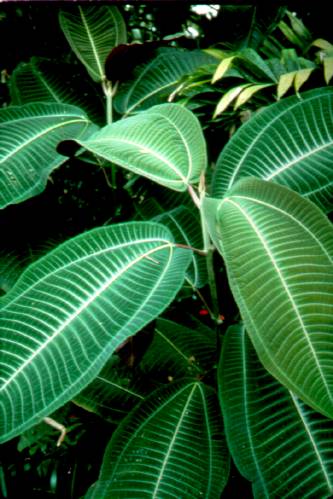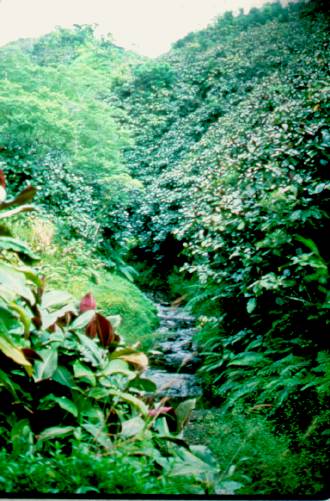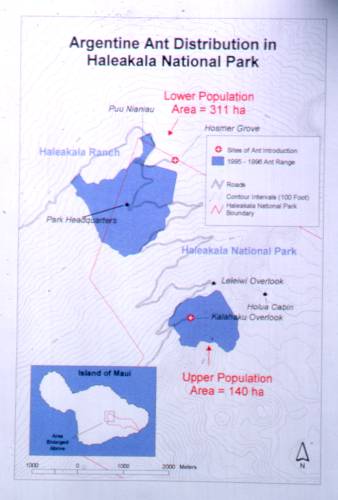USGS state fact sheet info from USGS/BRD/PIERC/HNPFS
This page provided as a service of the Hawaiian Ecosystems at Risk project (HEAR).
Here are some low-resolution images to allow USGS personnel to choose which, if any, would be appropriate for use with fact sheet info provided by USGS/BRD/PIERC/HFS. If higher-resolution digital images (ca. 3Mb uncompressed TIF files are available for most of these images) and/or copies of 35mm transparencies or photographic prints are needed by USGS personnel of any of these images, please send details of your request to webmaster@hear.org.
Note: Digital image quality will be much higher than those presented on this page for computer-generated graphics. These images were scanned from 35mm transparencies of photos of printed output. Final digital images of these subjects can be generated directly from the computer, and therefore the lighting/contrast/etc. problems will not be present in the final digital versions.
Miconia (Miconia calvescens [Melastomataceae])
BRD scientists in Hawaii, through cooperation with scientists in
French Polynesia, have laid the groundwork over the past eight
years for the statewide effort against the alien tree Miconia
calvescens, which arguably poses the greatest invasive plant
threat to rain forests of Hawaii and other high tropical Pacific
Islands. Native to mountains of Central and South America and
introduced to Tahiti in 1937, Miconia now forms the forest canopy
over 70% of that island; 30-40 endemic plant species of Tahiti
are near extinction solely due to the invasion of Miconia. A
major campaign, involving extensive interagency cooperation and
announced by the Governor as "Operation Miconia," is currently
underway in Hawaii to eradicate this alien tree.
-Lloyd L. Loope (USGS/BRD/PIERC/HFS)

Miconia calvescens leaves
(reference: miconia1-a.jpg)

Backside of Miconia calvescens leaf
(reference: miconia2-a.jpg)

Miconia calvescens inflorescence with young fruit
(reference: miconia3-a.jpg)

Under Miconia calvescens canopy (Tahiti)
(reference: miconia4-a.jpg)

Miconia calvescens covering hillsides in Tahiti
(reference: miconia5-a.jpg)

Landslide in Miconia calvescens-dominated mountainside (Tahiti)
(reference: miconia6-a.jpg)

Miconia calvescens tree in Hawaii
(reference: miconia7-a.jpg)
Argentine ant (Linepithema humilis (a.k.a. Iridomyrmex humile [Formicidae])
BRD has mapped the spread of the Argentine in Haleakala National
Park since 1980; the invasion front of this aggressive ant is
advancing 50-100 meters per year. Hawaii has no native ants, and
the biota has high local endemism, including pollinators and
flightless insect species, which are highly vulnerable to ant
predation. BRD has developed and is now refining methods for
stopping ant spread, in cooperation with the Clorox Corporation
and the National Park Service. -Lloyd L. Loope (USGS/BRD/PIERC/HFS)

Silverswords at Haleakala National Park, threatened by the Argentine ant
(reference: ants1-a.jpg)

Argentine ant distribution map, Haleakala National Park, Maui, Hawaii
(reference: ants2-a.jpg)

Potential Argentine ant range in Haleakala National Park, Maui, Hawaii
(reference: ants3-a.jpg)

Argentine ants at bait site
(reference: ants4-a.jpg)

Argentine ants tending the nest
(reference: ants5-a.jpg)
[
USGS/BRD/PIERC/HNPFS
]
[
Hawaiian Ecosystems at Risk
]
Comments, questions, feedback about this
website or its contents? e-mail the HEAR project (This document was created on 20 October 1998 by PT, and was last updated on
20 May 1999
by PT.)




